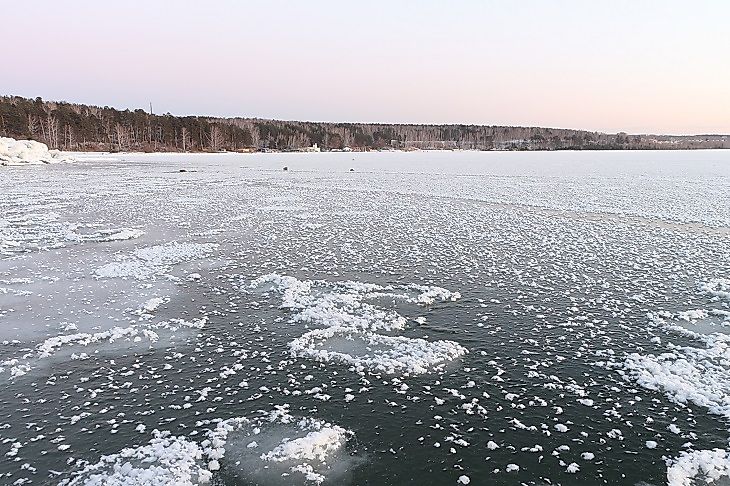The Ob River

5. Description
The Ob River, the seventh longest river in the world, flows for a distance of 3,650 kilometers in the Western Siberia region of the Russian Federation. This river, which is of great economic importance to Russia, arises at the confluence of its headwaters, the Biya and Katun Rivers in the Altai Mountains. The river passes primarily through Russian territories, though many of its tributaries drain land areas in neighboring China, Mongolia, and Kazakhstan as well. The Ob River is joined by its largest tributary, the Irtysh River, at about 69° East longitude. The river finally drains into the Kara Sea of the Arctic Ocean via the Gulf of Ob. The Ob has a massive catchment area that drains around 2,975,000 square kilometers.
4. Historical Role
The Ob River Basin was probably inhabited by early Siberian groups long before the invasion of the land by the Neo-Siberians, which occurred as recently as the 16th Century. Between 1581 and 1584, Yermak, a Russian folk hero, acted as the leader of an expedition that earned victory over the Ob River basin on behalf of the Russian Tsar Ivan IV. Soon, various Russian settlements and forts, like Tobolsk, Tyumen, Tomsk and others, cropped up along the banks of the Ob River. In the 17th and 18th Centuries, various explorers, realizing the huge economic potential of the Ob River basin, started exploring the entire course of the river. The upper and middle courses were mapped first, followed by the more remote lower courses of the Ob. The Great Northern Expedition of 1733-1742 involved the exploration of the lower reaches of the river by Russian scientists.
3. Modern Significance
Currently, the Ob River serves as a major navigable waterway, and one facilitating the transport of cargo from the interiors of Russia to the prime trade centers and major cities of the country. Both agricultural produce and industrial goods meant for import and export are traded along this water route. A large number of Siberian oil and natural gas fields, producing two-thirds of the country’s oil and natural gas, occur along the Ob River Basin. A significant number of industrial centers of the country, like Novosibirsk and Barnaul, are based along the banks of the river. Agriculture and animal ranching activities are popular in the steppe zones of the river's varied habitats. Fisheries are also well developed along the Ob River Basin, and large quantities of edible fish caught from the Ob are landed by Russian fishermen each year. The Ob River also holds the immense potential to generate around 250 billion Kilowatts of hydroelectric power. Three hydroelectric projects already exist along the Ob-Irtysh, one being situated on the Ob near Novosibirsk, and two others on the Irtysh at Bukhtarma and Öskemen, respectively.
2. Habitat
The habitat surrounding the Ob River is comprised by vast expanses of steppe and taiga flora in the upper and middle courses of the river. Birches, pines, firs, and cedars are some of the prominent trees populating these areas. Thickets of willows, wild roses, and bird cherry grow along the watercourse of the Ob River as well. The river basin is endowed with an abundance of aquatic life, including more than 50 types of fish, including sturgeons, carps, perches, nelmas, and peleds, to be found thriving within its waters. Over 150 species of birds, including many migratory species, can also be spotted around the Ob River. Minks, wolves, Siberian moles, otters, beavers, and ermines are some of the native mammalian species of these ecosystems. The lower reaches of the Ob River have an Arctic tundra type of habitat, itself characterized by an ice- and snow-covered landscape for a greater part of the year. In summers, the short duration melting of ice and snow results in the formation of vast areas of swampy and marshy wetlands, with their cold-tolerant plants and lichens. Polar bears, Arctic foxes, snowy owls, and Arctic hares are some of the fauna occurring in this tundra biome.
1. Threats and Disputes
The Ob River suffers from radioactive pollution introduced by the nuclear power plants operating in Russia. For example, in its nascent years, improper management of the Mayak Nuclear Facility has led to the dumping of harmful quantities of nuclear waste from the nuclear plant into the waters of the Techa River, a tributary of the Ob River. The presence of oil fields in and around the Ob river often leads to accidental oil spillage from oil tankers plying on the river into the waters of the river, killing aquatic species on a massive scale as a result. Furthermore, the high population pressures from residential communities along the Ob River Basin, as well as pollutants generated by industries and agricultural farms based along the river and the exploitative practices of commercial Russian fisheries, inflict damage on the natural ecosystems of the Ob River.











